Micromechanics-Based Low Cycle Fatigue Life Prediction Model of ECAPed Aluminum Alloy
Abstract
:1. Introduction
2. Material and Experimental Procedures
3. Simulation Methodology
3.1. The Crystal Plastic Constitutive Model
3.2. Indicator Parameters for Fatigue Damages
3.3. Proposed Fatigue Life Approach
4. Results and Discussion
4.1. Simulating the Cyclic Plasticity Behavior of UFG AA6061
4.2. The Relationship between Stress Triaxiality and PSED
4.3. Fatigue Indicator Parameter Based on the Micro-Multiaxial Strain Field
4.4. Micromechanics Based LCF Life of UFG AA6061
5. Conclusions
- The accumulated plastic strain energy, modulated by triaxiality, is regarded as the FIP to assess the fatigue damage of multiple potential locations. Since this parameter is independent of the type of materials and has a clear physical meaning, it can comprehensively reflect the combined mechanical response of cyclic stress and strain at the grain level, as well as the correlation of strain path in multiaxial and non-proportional cyclic loading;
- The local stress and strain field in the FDR and CPR regions on the slip plane evolve in a multiaxial state. The parameters in cyclic J-integral related to the stress state ahead of the small crack tip must be modified to adapt to the multiaxial and non-proportional state. In addition, the appropriate critical values can be determined by a family of cyclic experiments, combined with CPFEM simulations from the perspective of energy evolution;
- According to the Mises criterion, the multiaxial strain, with consideration of the NPACH effect and equivalent mean strain, was regarded as the driving force for small crack propagation. More reasonable LCF fatigue life prediction results can be obtained using the FIPs proposed in this paper, which means that the description of the multiaxial strain field by the new indicator parameters is closer to the actual process.
Author Contributions
Funding
Data Availability Statement
Conflicts of Interest
References
- Kumar, N.; Goel, S.; Jayaganthan, R.; Owolabi, G.M. The influence of metallurgical factors on low cycle fatigue behavior of ultra-fine grained 6082 Al alloy. Int. J. Fatigue 2018, 110, 130–143. [Google Scholar] [CrossRef]
- Salcedo, D.; Luis, C.J.; Puertas, I.; León, J.; Luri, R.; Fuertes, J.P. FEM Modelling and Experimental Analysis of an AA5083 Turbine Blade from ECAP Processed Material. Mater. Manuf. Process. 2014, 29, 434–441. [Google Scholar] [CrossRef]
- Balasubramanian, R.; Nagumothu, R.; Parfenov, E.; Valiev, R. Development of nanostructured titanium implants for biomedical implants—A short review. Mater. Today Proc. 2021, 46, 1195–1200. [Google Scholar] [CrossRef]
- Luis Pérez, C.J.; Salcedo Pérez, D.; Puertas Arbizu, I. Design and mechanical property analysis of ultrafine grained gears from AA5083 previously processed by equal channel angular pressing and isothermal forging. Mater. Des. 2014, 63, 126–135. [Google Scholar] [CrossRef]
- Luri, R.; Luis, C.J.; León, J.; Fuertes, J.P.; Salcedo, D.; Puertas, I. Analysis of Fatigue and Wear Behaviour in Ultrafine Grained Connecting Rods. Metals 2017, 7, 289. [Google Scholar] [CrossRef] [Green Version]
- Zhao, P.C.; Chen, B.; Zheng, Z.G.; Guan, B.; Zhang, X.C.; Tu, S.T. Microstructure and Texture Evolution in a Post-dynamic Recrystallized Titanium During Annealing, Monotonic and Cyclic Loading. Metall. Mater. Trans. A 2021, 52, 394–412. [Google Scholar] [CrossRef]
- Zhao, P.; Chen, B.; Kelleher, J.; Yuan, G.; Guan, B.; Zhang, X.; Tu, S. High-cycle-fatigue induced continuous grain growth in ultrafine-grained titanium. Acta Mater. 2019, 174, 29–42. [Google Scholar] [CrossRef]
- Zhang, Y.; Chen, H.; Jia, Y.-F.; Li, D.-F.; Yuan, G.-J.; Zhang, X.-C.; Tu, S.-T. A modified kinematic hardening model considering hetero-deformation induced hardening for bimodal structure based on crystal plasticity. Int. J. Mech. Sci. 2021, 191, 106068. [Google Scholar] [CrossRef]
- Zhang, X.-C.; Li, H.-C.; Zeng, X.; Tu, S.-T.; Zhang, C.-C.; Wang, Q.-Q. Fatigue behavior and bilinear Coffin-Manson plots of Ni-based GH4169 alloy with different volume fractions of δ phase. Mater. Sci. Eng. A 2017, 682, 12–22. [Google Scholar] [CrossRef]
- Zhang, K.-S.; Ju, J.W.; Li, Z.; Bai, Y.-L.; Brocks, W. Micromechanics based fatigue life prediction of a polycrystalline metal applying crystal plasticity. Mech. Mater. 2015, 85, 16–37. [Google Scholar] [CrossRef] [Green Version]
- Zhang, K.-S.; Shi, Y.-K.; Ju, J.W. Grain-level statistical plasticity analysis on strain cycle fatigue of a FCC metal. Mech. Mater. 2013, 64, 76–90. [Google Scholar] [CrossRef]
- Castelluccio, G.M.; McDowell, D.L. Mesoscale modeling of microstructurally small fatigue cracks in metallic polycrystals. Mater. Sci. Eng. A 2014, 26, 34–55. [Google Scholar] [CrossRef]
- Li, D.-F.; Davies, C.M.; Zhang, S.-Y.; Dickinson, C.; O’Dowd, N.P. The effect of prior deformation on subsequent microplasticity and damage evolution in an austenitic stainless steel at elevated temperature. Acta Mater. 2013, 61, 3575–3584. [Google Scholar] [CrossRef] [Green Version]
- Yuan, G.-J.; Zhang, X.-C.; Chen, B.; Tu, S.-T.; Zhang, C.-C. Low-cycle fatigue life prediction of a polycrystalline nickel-base superalloy using crystal plasticity modelling approach. J. Mater. Sci. Technol. 2020, 38, 28–38. [Google Scholar] [CrossRef]
- Wang, J.; Jiang, W. Numerical assessment on fatigue damage evolution of materials at crack tip of CT specimen based on CPFEM. Theor. Appl. Fract. Mech. 2020, 109, 102687. [Google Scholar] [CrossRef]
- Li, D.-F.; Barrett, R.A.; O’Donoghue, P.E.; O’Dowd, N.P.; Leen, S.B. A multi-scale crystal plasticity model for cyclic plasticity and low-cycle fatigue in a precipitate-strengthened steel at elevated temperature. J. Mech. Phys. Solids 2017, 101, 44–62. [Google Scholar] [CrossRef] [Green Version]
- Hao, Y.; Wei, Z.; Castelluccio, G.M.; Kim, J.; Liu, Y. Microstructure-sensitive Estimation of Small Fatigue Crack Growth in Bridge Steel Welds. Int. J. Fatigue 2018, 112, 183–197. [Google Scholar]
- Vishnu, P.; Raj Mohan, R.; Krishna Sangeethaa, E.; Raghuraman, S.; Venkatraman, R. A review on processing of aluminium and its alloys through Equal Channel Angular Pressing die. Mater. Today Proc. 2020, 21, 212–222. [Google Scholar] [CrossRef]
- Estrin, Y.; Vinogradov, A. Fatigue behaviour of light alloys with ultrafine grain structure produced by severe plastic deformation: An overview. Int. J. Fatigue 2010, 32, 898–907. [Google Scholar] [CrossRef]
- Sga, B.; Sm, B. Fracture toughness characteristics of ultrafine grained Nb–Ti stabilized microalloyed and interstitial free steels processed by advanced multiphase control rolling. Mater. Charact. 2020, 159, 110003. [Google Scholar]
- Hohenwarter, A.; Pippan, R. Fracture toughness evaluation of ultrafine-grained nickel. Scr. Mater. 2011, 64, 982–985. [Google Scholar] [CrossRef]
- Kumar, N.; Owolabi, G.M.; Jayaganthan, R. Al 6082 alloy strengthening through low strain multi-axial forging. Mater. Charact. 2019, 155, 109761. [Google Scholar] [CrossRef]
- Ding, H.Z.; Mughrabi, H.; Höppel, H.W. Alow-cycle fatigue life prediction model of ultrafine-grained metals. Fatigue Fract. Eng. Mater. Struct. 2002, 25, 975–984. [Google Scholar] [CrossRef]
- Musinski, W.D.; McDowell, D.L. Simulating the effect of grain boundaries on microstructurally small fatigue crack growth from a focused ion beam notch through a three-dimensional array of grains. Acta Mater. 2016, 112, 20–39. [Google Scholar] [CrossRef]
- Potirniche, G.P.; Daniewicz, S.R. Analysis of crack tip plasticity for microstructurally small cracks using crystal plasticity theory. Eng. Fract. Mech. 2003, 70, 1623–1643. [Google Scholar] [CrossRef]
- McDowell, D.L.; Berard, J.Y. A ΔJ-based approach to biaxial fatigue. Fatigue Fract. Eng. Mater. Struct. Aug. 1992, 15, 719–741. [Google Scholar] [CrossRef]
- Shenoy, M.; Zhang, J.; McDowell, D.L. Estimating fatigue sensitivity to polycrystalline Ni-base superalloy microstructures using a computational approach. Fatigue Fract. Eng. Mater. Struct. 2007, 30, 889–904. [Google Scholar] [CrossRef]
- Moosbrugger, J.C.; Batane, N.R.; Morrison, D.J. Modeling aspects of low plastic strain amplitude multiaxial cyclic plasticity in conventional and ultrafine grain nickel. Int. J. Plast. 2008, 24, 1837–1862. [Google Scholar] [CrossRef]
- Tong, J.; Lin, B.; Lu, Y.W.; Madi, K.; Tai, Y.H.; Yates, J.R.; Doquet, V. Near-tip strain evolution under cyclic loading: In situ experimental observation and numerical modelling. Int. J. Fatigue 2015, 71, 45–52. [Google Scholar] [CrossRef]
- Zhao, B.; Xie, L.; Song, J.; Zhao, Z.; Xu, G. Prediction of multiaxial fatigue life for complex three imensional stress state considering effect of additional hardening. Fatigue Fract. Eng. Mater. Struct. 2019, 42, 2558–2578. [Google Scholar] [CrossRef]
- Cailletaud, G. A micromechanical approach to inelastic behaviour of metals. Int. J. Plast. 1992, 8, 55–73. [Google Scholar] [CrossRef]
- Roters, F.; Eisenlohr, P.; Hantcherli, L.; Tjahjanto, D.D.; Bieler, T.R.; Raabe, D. Overview of constitutive laws, kinematics, homogenization and multiscale methods in crystal plasticity finite-element modeling: Theory, experiments, applications. Acta Mater. 2010, 58, 1152–1211. [Google Scholar] [CrossRef]
- Farooq, H.; Cailletaud, G.; Forest, S.; Ryckelynck, D. Crystal plasticity modeling of the cyclic behavior of polycrystalline aggregates under non-symmetric uniaxial loading: Global and local analyses. Int. J. Plast. 2020, 126, 102619. [Google Scholar] [CrossRef] [Green Version]
- Mecking, H.; Kocks, U.F. Kinetics of flow and strain-hardening. Acta Metallurgica 1981, 29, 1865–1875. [Google Scholar] [CrossRef]
- Wan, V.V.C.; MacLachlan, D.W.; Dunne, F.P.E. A stored energy criterion for fatigue crack nucleation in polycrystals. Int. J. Fatigue 2014, 68, 90–102. [Google Scholar] [CrossRef]
- Anahid, M.; Samal, M.K.; Ghosh, S. Dwell fatigue crack nucleation model based on crystal plasticity finite element simulations of polycrystalline titanium alloys. J. Mech. Phys. Solids 2011, 59, 2157–2176. [Google Scholar] [CrossRef]
- Mbiakop, A.; Constantinescu, A.; Danas, K. An analytical model for porous single crystals with ellipsoidal voids. J. Mech. Phys. Solids 2015, 84, 436–467. [Google Scholar] [CrossRef] [Green Version]
- Li, D.-F.; O’Dowd, N.P. On the evolution of lattice deformation in austenitic stainless steels—The role of work hardening at finite strains. J. Mech. Phys. Solids 2011, 59, 2421–2441. [Google Scholar] [CrossRef]
- Shang, D.-G.; Wang, D.-J.; Yao, W.-X. A simple approach to the description of multiaxial cyclic stress-strain relationship. Int. J. Fatigue 2000, 22, 251–256. [Google Scholar] [CrossRef]
- Yao, Y.; Wang, J.; Keer, L.M. A phase transformation based method to predict fatigue crack nucleation and propagation in metals and alloys. Acta Mater. 2017, 127, 244–251. [Google Scholar] [CrossRef]
- Rice, J.R. A Path Independent Integral and the Approximate Analysis of Strain Concentration by Notches and Cracks. J. Appl. Mech. 1968, 35, 379–386. [Google Scholar] [CrossRef] [Green Version]
- Broek, D. Elementary Engineering Fracture Mechanics; Springer Science & Business Media: Berlin, Germany, 1982. [Google Scholar]
- Rao, P.N.; Singh, D.; Brokmeier, H.-G.; Jayaganthan, R. Effect of ageing on tensile behavior of ultrafine grained Al 6061 alloy. Mater. Sci. Eng. A 2015, 641, 391–401. [Google Scholar] [CrossRef]
- Khan, A.S.; Liu, J. A deformation mechanism based crystal plasticity model of ultrafine-grained/nanocrystalline FCC polycrystals. Int. J. Plast. 2016, 86, 56–69. [Google Scholar] [CrossRef]
- Halliday, M.D.; Bowen, P. Fatigue extrusions, slip band cracking and a novel hybrid concept for fatigue crack closure close to the crack tip. Int. J. Fatigue 2011, 33, 1277–1285. [Google Scholar] [CrossRef]
- McDowell, D.L. An Experimental Study of the Structure of Constitutive Equations for Nonproportional Cyclic Plasticity. J. Eng. Mater. Technol. 1985, 107, 307–315. [Google Scholar] [CrossRef]
- Borodii, M.V.; Shukaev, S.M. Additional cyclic strain hardening and its relation to material structure, mechanical characteristics, and lifetime. Int. J. Fatigue 2007, 29, 1184–1191. [Google Scholar] [CrossRef]
- Yang, M.; Lu, S. A microstructure-based homogenization model for predicting the low-cycle fatigue initiation life of GH4169 superalloy. Fatigue Fract. Eng. Mater. Struct. 2021, 44, 1546–1561. [Google Scholar] [CrossRef]
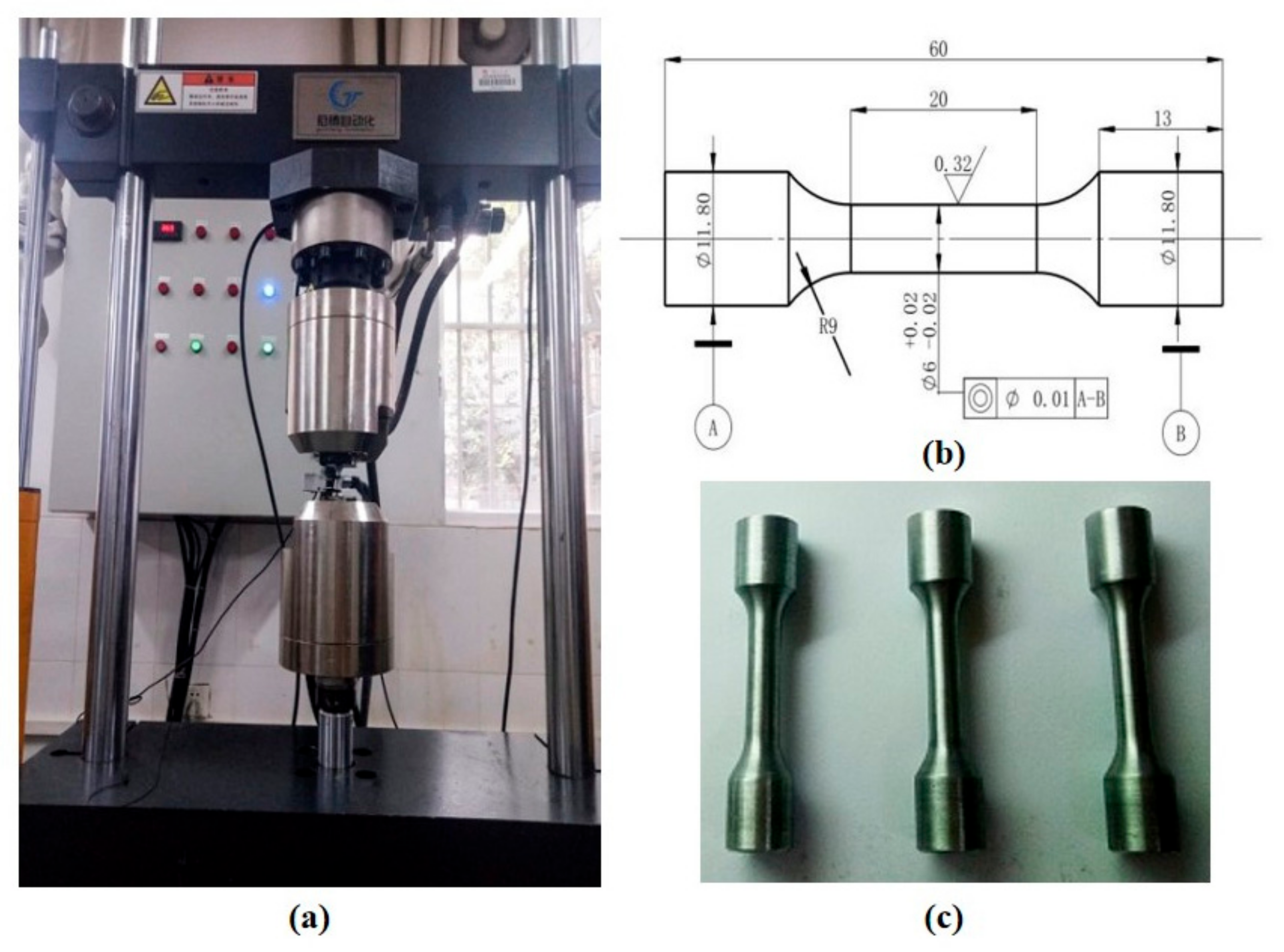
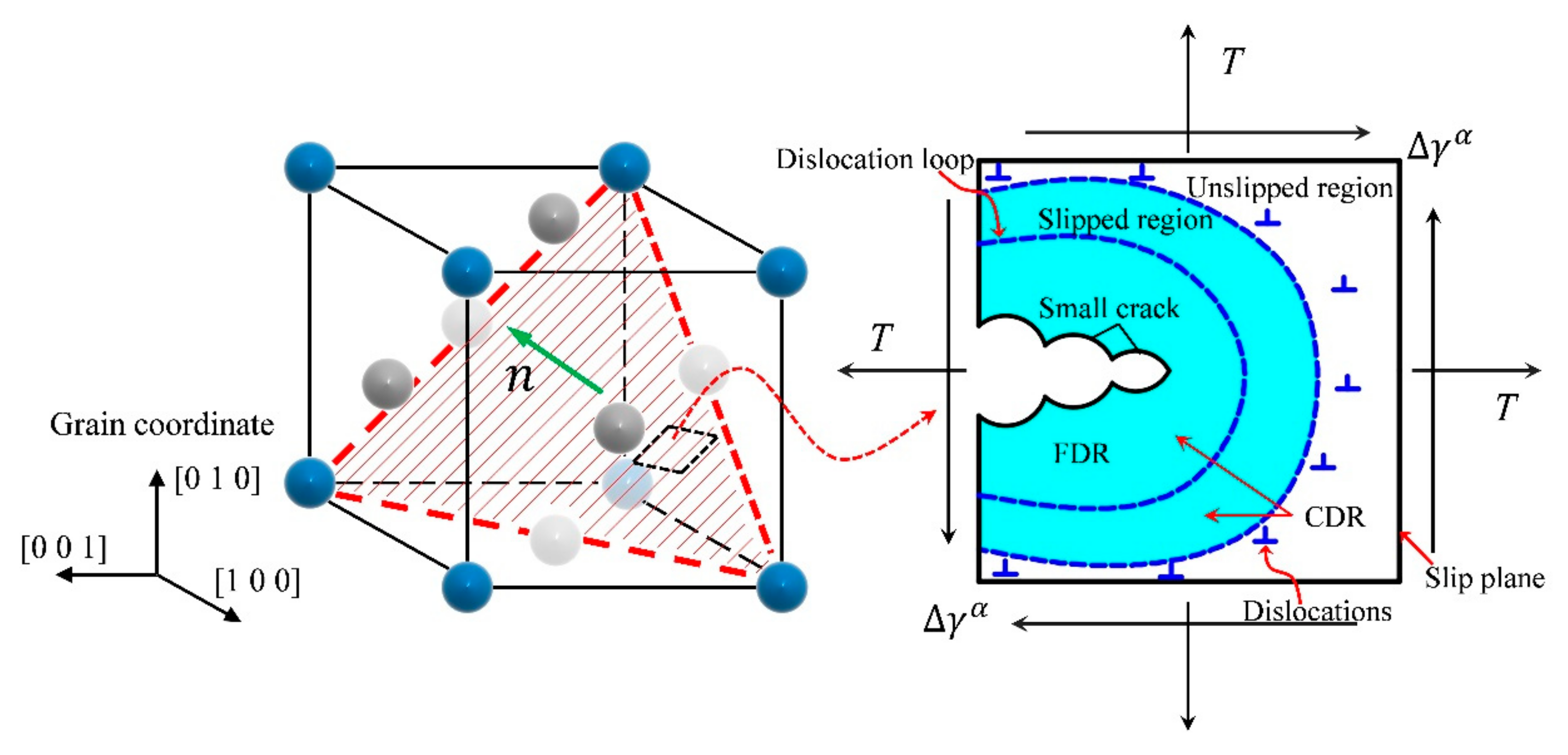

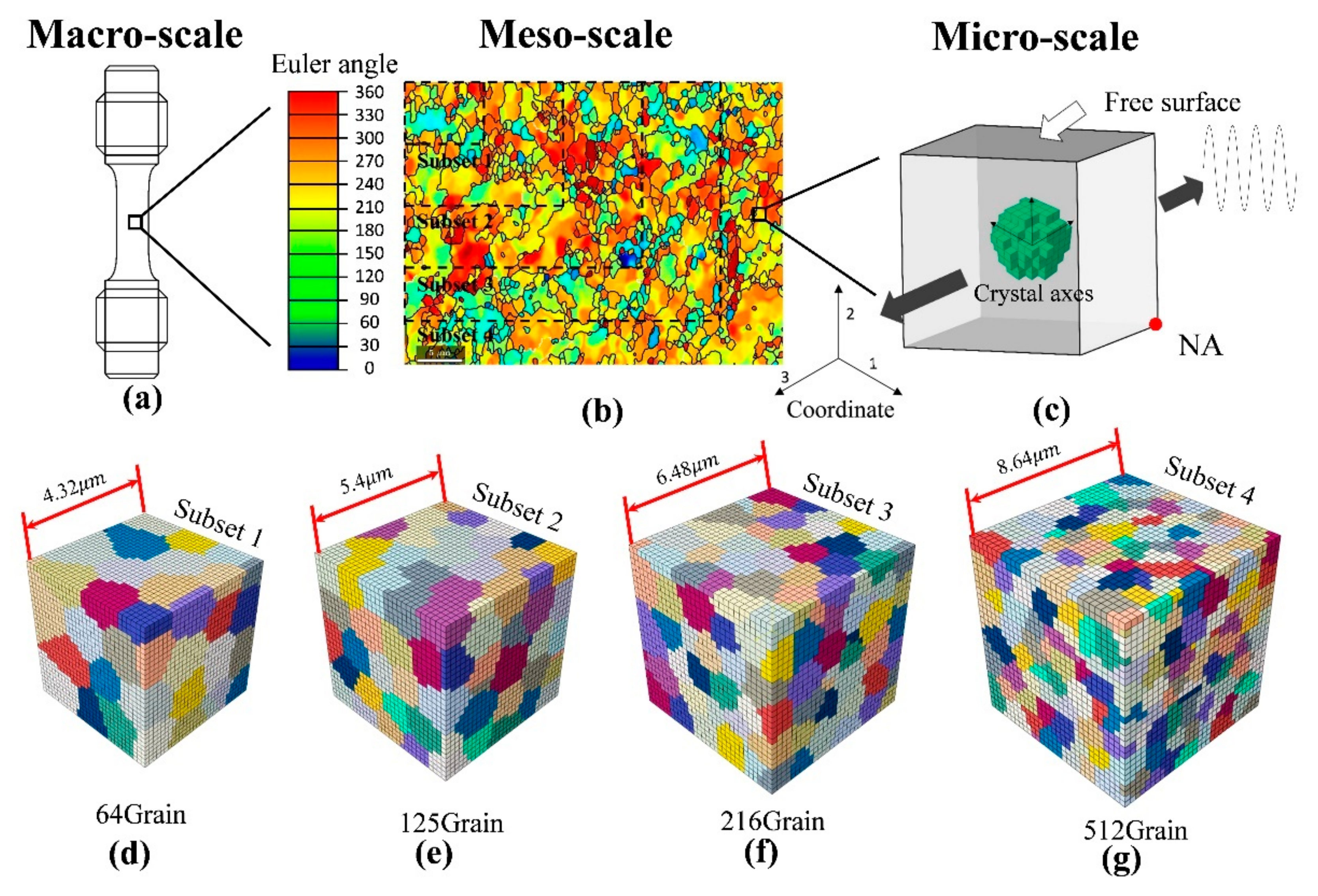
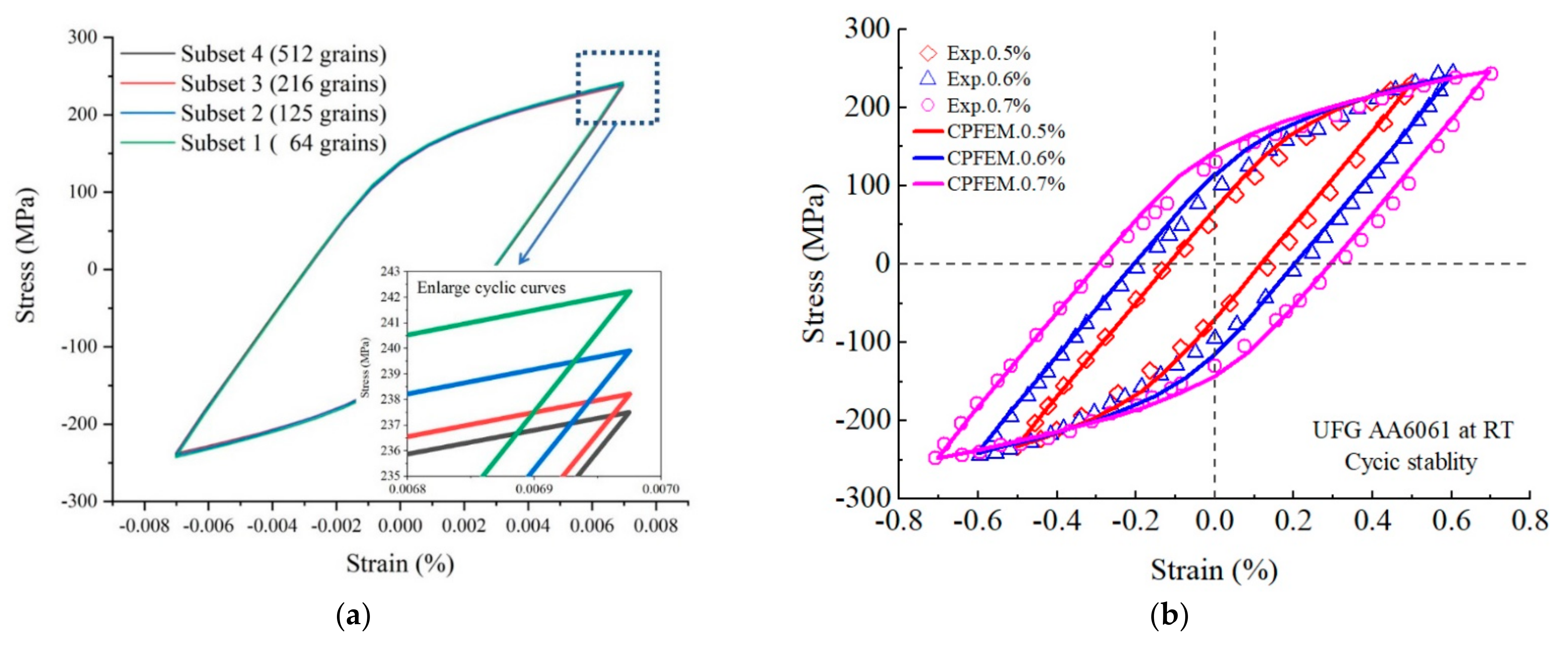
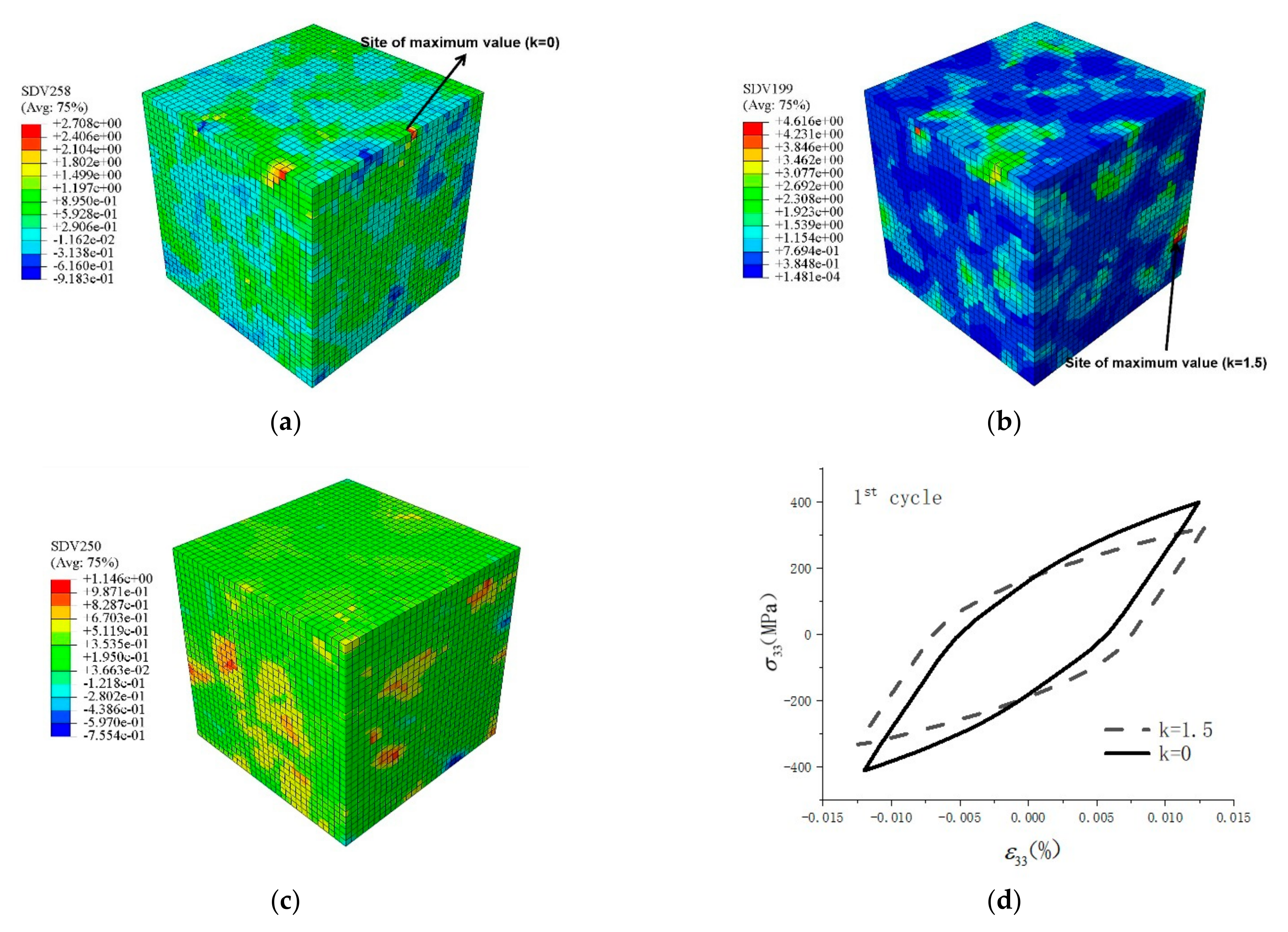
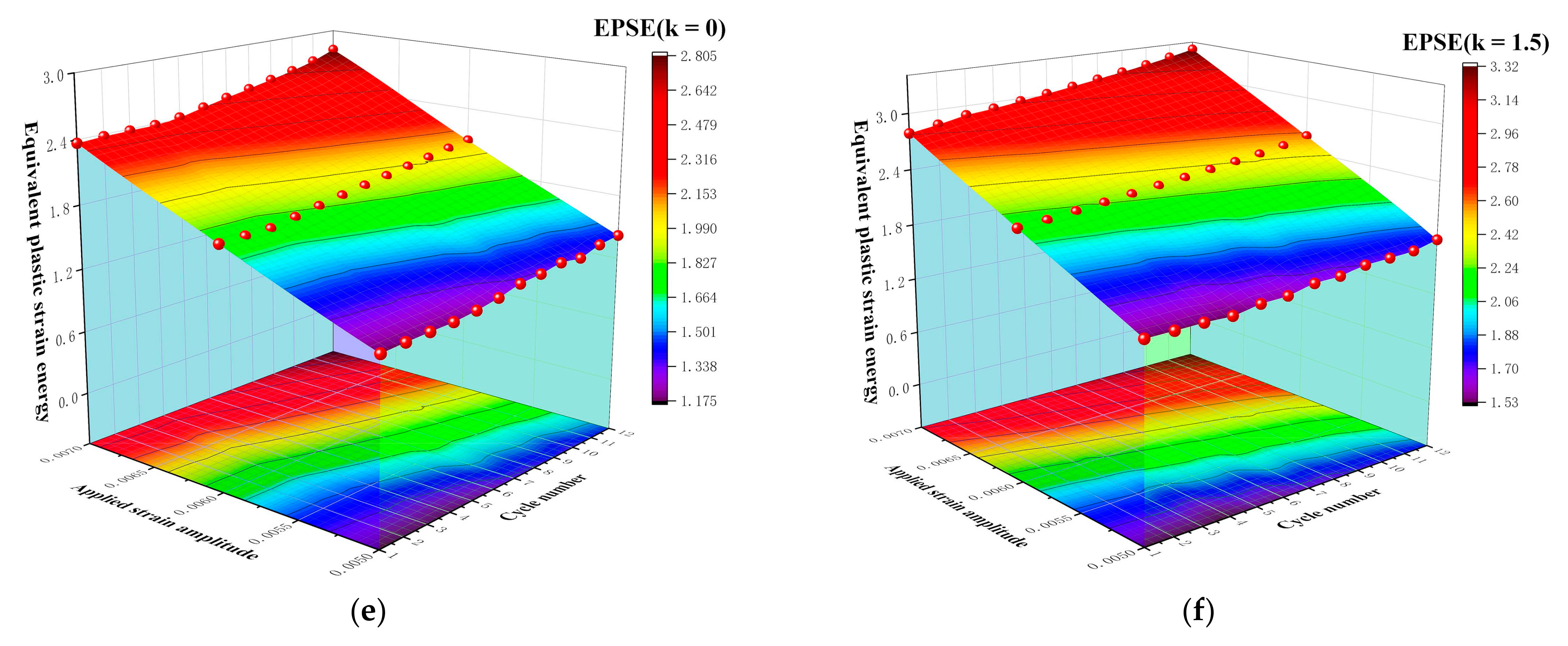
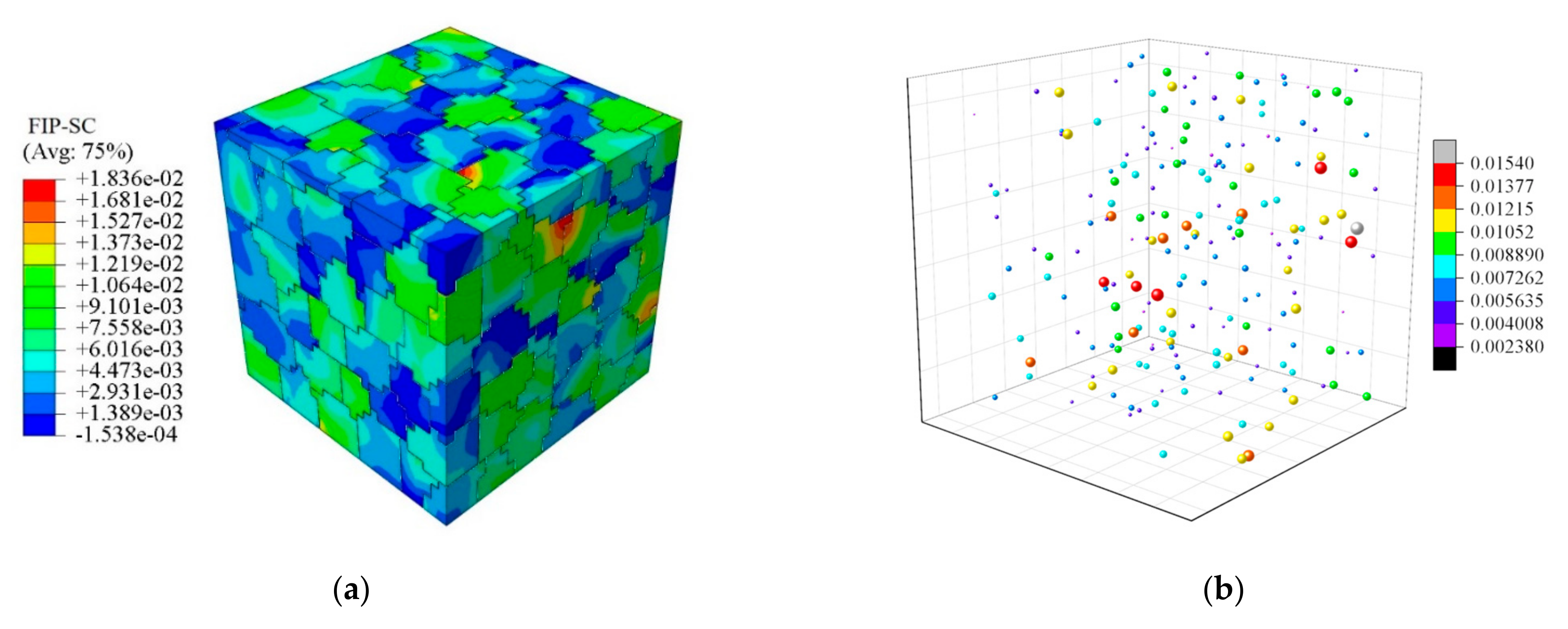
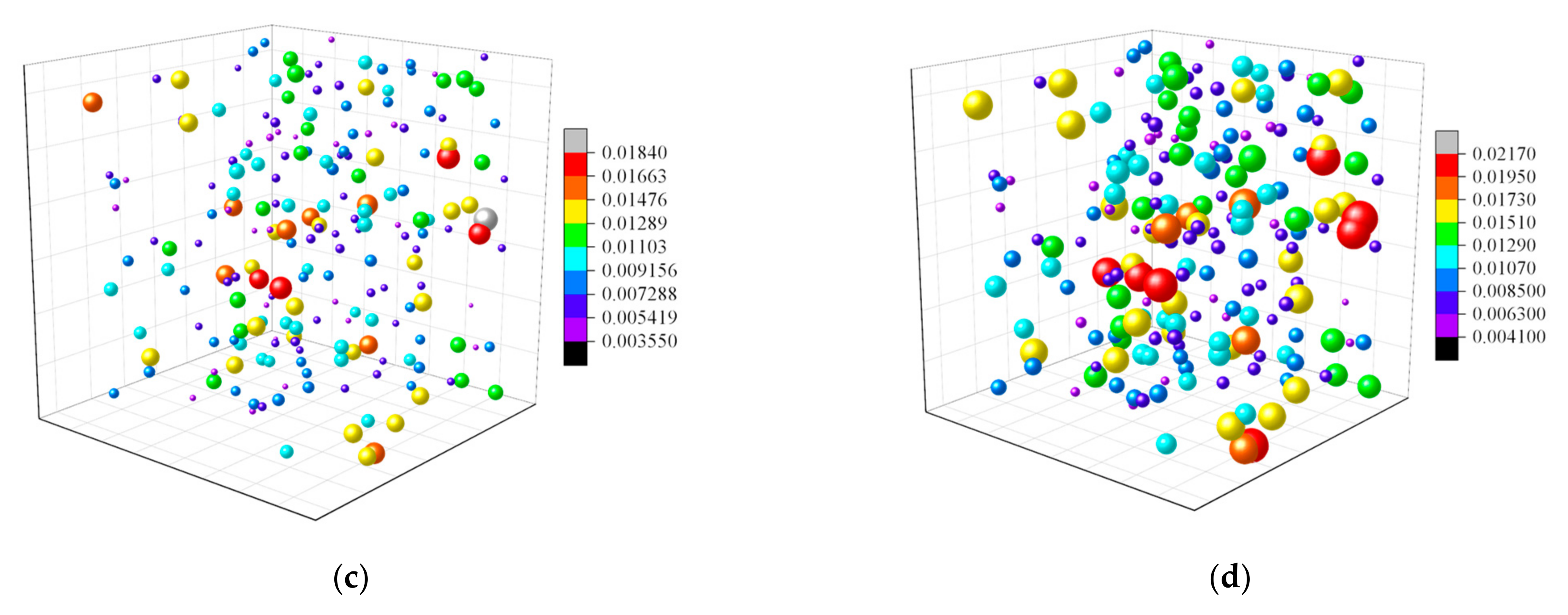

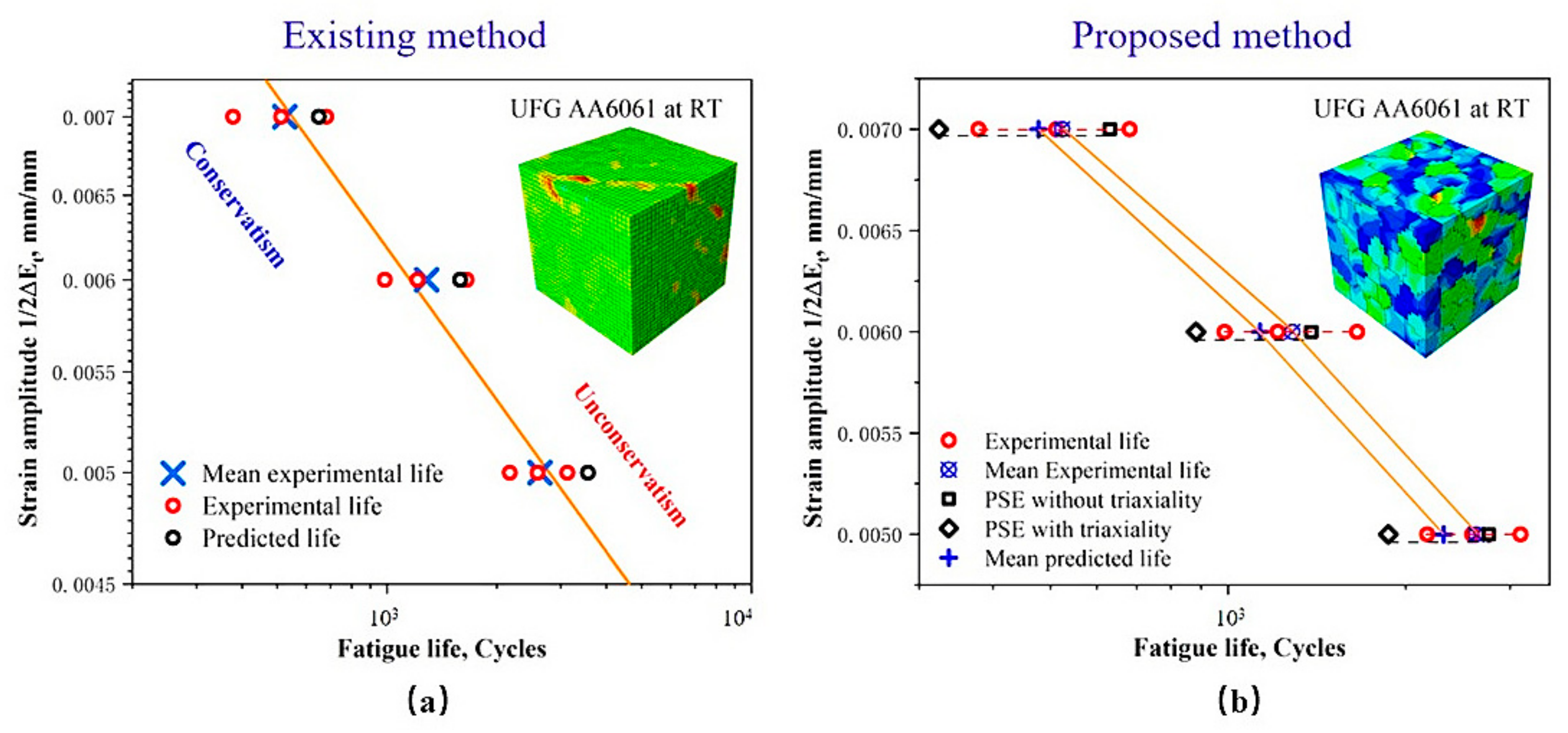
| Si | Fe | Cu | Mn | Mg | Cr | Zn | Ti |
|---|---|---|---|---|---|---|---|
| 0.586 | 0.241 | 0.264 | 0.095 | 0.945 | 0.07 | 0.024 | 0.005 |
| Parameter Type | Material Parameters |
|---|---|
| Elastic constants: | C11 = 77,159 MPa, C12 = 55,706 Mpa, C44 = 35,910 Mpa |
| Flow rule: | , n = 50 |
| Kinematic hardening rule: | C = 8831 Mpa, D = 118 |
| Isotropic hardening rule: | ΔGB = 87,000 J/mol, T = 300 K, kB = 1.38 × 10−23, b = 0.286 nm, y0 = 0.9 × 10−25, h0 = 0.014, K = 3.55, ω1 = 1, ω2 = 1 |
| Materials | Cyclic Yield Strength | Strengthening Factor | ||
|---|---|---|---|---|
| UFG AA6061/RT state | 0.21 | 484 | 139 | 2.1 |
| CG AA6061/RT state | 0.15 | 168 | 66 |
| 0.5 | 3125/2173/2589 | 2629 | 3558 | 0.35 | 1958 | −0.26 |
| 0.6 | 1653/986/1213 | 1284 | 1587 | 0.24 | 982 | −0.24 |
| 0.7 | 512/378/681 | 524 | 650 | 0.24 | 424 | −0.19 |
Publisher’s Note: MDPI stays neutral with regard to jurisdictional claims in published maps and institutional affiliations. |
© 2022 by the authors. Licensee MDPI, Basel, Switzerland. This article is an open access article distributed under the terms and conditions of the Creative Commons Attribution (CC BY) license (https://creativecommons.org/licenses/by/4.0/).
Share and Cite
Sun, T.; Xie, Y.; Pan, Y.; Zheng, Z.; Xie, C.; Huang, Z. Micromechanics-Based Low Cycle Fatigue Life Prediction Model of ECAPed Aluminum Alloy. Metals 2022, 12, 1127. https://doi.org/10.3390/met12071127
Sun T, Xie Y, Pan Y, Zheng Z, Xie C, Huang Z. Micromechanics-Based Low Cycle Fatigue Life Prediction Model of ECAPed Aluminum Alloy. Metals. 2022; 12(7):1127. https://doi.org/10.3390/met12071127
Chicago/Turabian StyleSun, Teng, Yiji Xie, Yuchen Pan, Zhanguang Zheng, Changji Xie, and Zeng Huang. 2022. "Micromechanics-Based Low Cycle Fatigue Life Prediction Model of ECAPed Aluminum Alloy" Metals 12, no. 7: 1127. https://doi.org/10.3390/met12071127
APA StyleSun, T., Xie, Y., Pan, Y., Zheng, Z., Xie, C., & Huang, Z. (2022). Micromechanics-Based Low Cycle Fatigue Life Prediction Model of ECAPed Aluminum Alloy. Metals, 12(7), 1127. https://doi.org/10.3390/met12071127






